#the first starr
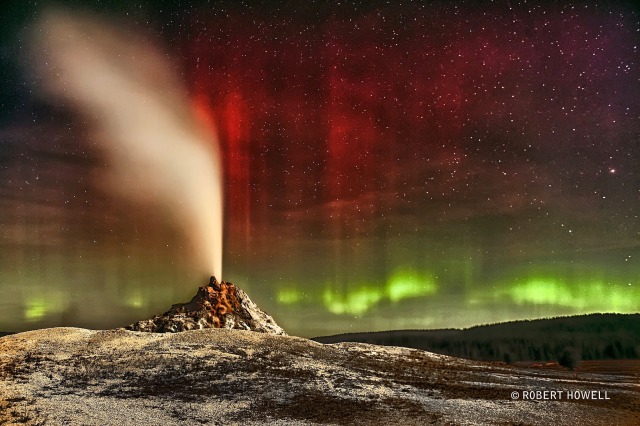
Colourful auroras erupted unexpectedly a few years ago, with green aurora appearing near the horizon and brilliant bands of red aurora high overhead. The Moon lit the foreground of this scene, while familiar stars could be seen in the distance. The astrophotographer shot this image mosaic in the field of White Dome Geyser in Yellowstone National Park in the western USA. Sure enough, just after midnight, the geyser erupted – spraying a stream of water and vapor many meters into the air. Geyser water is heated to steam by scalding magma several kilometers below, and rises through rock cracks to the surface. About half of all known geysers occur in Yellowstone National Park.
Image Credit & Copyright: Robert Howell



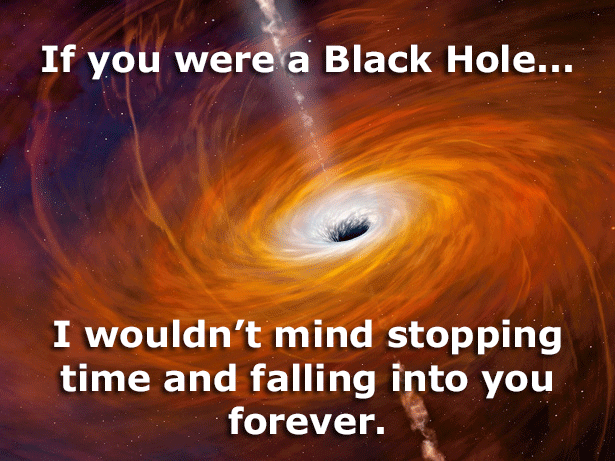

Happy Valentine’s Day loves!!!
We’re back again with more space/science themed Valentine’s Day cards to send to everyone you love- including yourself because self love is the most important love of them all
Love you all!
❤️❤️❣️

Similar in size to large, bright spiral galaxies in our neighborhood, IC 342 is a mere 10 million light-years distant in the northern constellation of Camelopardalis. It would be a prominent galaxy in our night sky, but it is hidden from clear view and only glimpsed through the veil of stars, gas and dust clouds along the plane of the Milky Way galaxy. Even though IC 342’s light is dimmed and reddened by intervening cosmic clouds, this sharp telescopic image shows the galaxy’s dust, young star clusters, and glowing pink star forming regions along spiral arms that wind far from the galaxy’s core. IC 342 may have undergone a recent burst of star formation activity and is close enough to have gravitationally influenced the evolution of the local group of galaxies and the Milky Way.
Image Credit & Copyright: Daniel Feller

What will become of Jupiter’s Great Red Spot? Gas giant Jupiter is the solar system’s largest world with about 320 times the mass of planet Earth. Jupiter is home to one of the largest and longest lasting storm systems known, the Great Red Spot (GRS), visible to the left. The GRS is so large it could swallow Earth- but it has been shrinking. Comparison with historical notes indicate that the storm spans only about one third of the exposed surface area it had 150 years ago. NASA’s Outer Planets Atmospheres Legacy (OPAL) program has been monitoring the storm more recently using the Hubble Space Telescope. The featured Hubble OPAL image shows Jupiter as it appeared in 2016, processed in a way that makes red hues appear quite vibrant. Modern GRS data indicate that the storm continues to constrict its surface area, but is also becoming slightly taller, vertically. No one knows the future of the GRS, including the possibility that if the shrinking trend continues, the GRS might one day even do what smaller spots on Jupiter have done – disappear completely.
Image Credit: NASA, ESA, Hubble, OPAL Program, STScI; Processing: Karol Masztalerz

It’s easy to get lost following the intricate, looping, twisting filaments in this detailed image of supernova remnant Simeis 147 or, as it’s better known as, the Spaghetti Nebula. Seen about 3,000 light years away, toward the boundary of the constellations Taurus and Auriga, it covers nearly 3 degrees or 6 full moons on the sky- about 150 light-years wide. This composite image includes data taken through narrow-band filters where the reddish emission is from ionized hydrogen atoms and doubly ionized oxygen atoms is in faint blue-green hues. The supernova remnant has an estimated age of about 40,000 years, meaning light from the massive stellar explosion first reached Earth 40,000 years ago. But the expanding remnant is not the only aftermath. The cosmic catastrophe also left behind a spinning neutron star, or pulsar. It’s all that remains of the original star’s core.
Happy new year everyone!
Image Credit & Copyright: Jason Dain
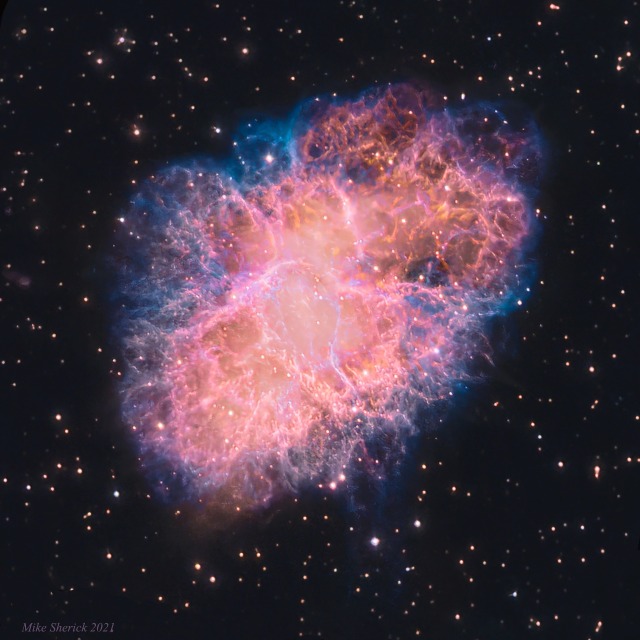
The Crab Nebula is cataloged as M1, the first object on Charles Messier’s famous 18th century list of things which are not comets. In fact, the Crab is now known to be a supernova remnant, debris from the death explosion of a massive star, witnessed by astronomers in the year 1054. This sharp, ground-based telescopic view combines broadband color data with narrowband data that tracks the emissions from ionized sulfur, hydrogen, and oxygen atoms to explore the tangled filaments within the still expanding cloud. One of the most exotic objects known to modern astronomers, the Crab Pulsar, a neutron star spinning 30 times a second, is visible as a bright spot near the nebula’s center. Like a cosmic dynamo, this collapsed remnant of the stellar core powers the Crab’s emission across the electromagnetic spectrum. Spanning about 12 light-years, the Crab Nebula is a mere 6,500 light-years away in the constellation Taurus.
Image Credit & Copyright: Michael Sherick

Halloween’s origin is ancient and astronomical. Since the fifth century BC, Halloween has actually been celebrated as a cross-quarter day, a day halfway between an equinox (equal day / equal night) and a solstice (minimum day / maximum night in the northern hemisphere). With a modern calendar however, even though Halloween occurs next week, the real cross-quarter day will occur the week after. Another cross-quarter day is Groundhog Day!
Halloween’s modern celebration retains historic roots in dressing to scare away the spirits of the dead. Perhaps a fitting tribute is this view of the Ghost Head Nebula (NGC 2080) taken with the Hubble Space Telescope. Similar to the icon of a fictional ghost, it is actually a star forming region in the Large Magellanic Cloud, a satellite galaxy of the Milky Way Galaxy. The nebula spans about 50 light-years and is shown in representative colors.
Image Credit: Mohammad Heydari-Malayeri (Observatoire de Paris) et al., ESA, NASA

What’s happening to this cirrus cloud? Ice crystals are acting like little floating prisms. Known informally as a fire rainbow for its flame-like appearance, a circumhorizon arc appears parallel to the horizon. For a circumhorizontal arc to be visible, the Sun must be at least 58 degrees high in a sky where cirrus clouds present below. The numerous, flat, hexagonal ice-crystals that compose the cirrus cloud must be aligned horizontally to properly refract sunlight in a similar manner. Therefore, circumhorizontal arcs are somewhat unusual to see. The featured fire rainbow was photographed earlier this month near West Virginia, USA.
Image Credit: Christa Harbig
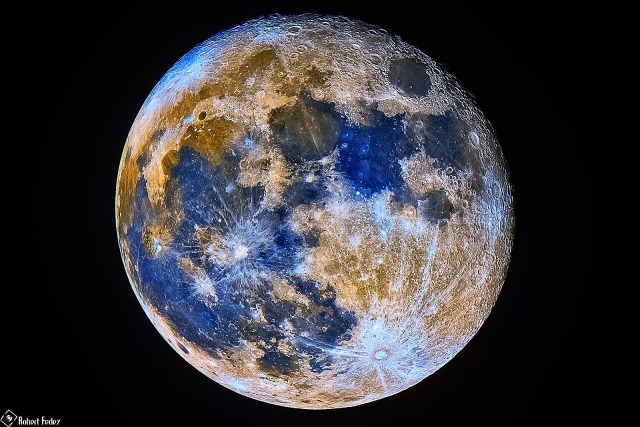
The Moon is normally seen in subtle shades of grey or gold. But small, measurable color differences have been greatly exaggerated to make this telescopic, multicoloured, moonscape captured during a full moon. The different colors are recognized to correspond to differences in the surface’s chemical makeup. Blue hues reveal titanium rich areas while orange and purple colors show regions relatively poor in titanium and iron. The familiar Sea of Tranquility, or Mare Tranquillitatis, is the blue area toward the upper right. White lines radiate across the orange-hued southern lunar highlands from the ray-crater Tycho at bottom right. This image is made up of 272 different images!
Image Credit & Copyright: Robert Fedez

The Ring Nebula (M57), is more complicated than it appears through a small telescope. The easily visible central ring is about one light-year across, but this remarkably deep exposure shows in detail the looping filaments of glowing gas extending much farther from the nebula’s central star. This image, taken by combining data from three different large telescopes, includes red light emitted by hydrogen as well as visible and infrared light. The Ring Nebula is an elongated planetary nebula, a type of nebula created when a Sun-like star evolves to throw off its outer atmosphere to become a white dwarf star. The Ring Nebula is about 2,500 light-years away from us here on Earth.
Image Credit: Hubble, Large Binocular Telescope, Subaru Telescope; Composition & Copyright: Robert Gendler
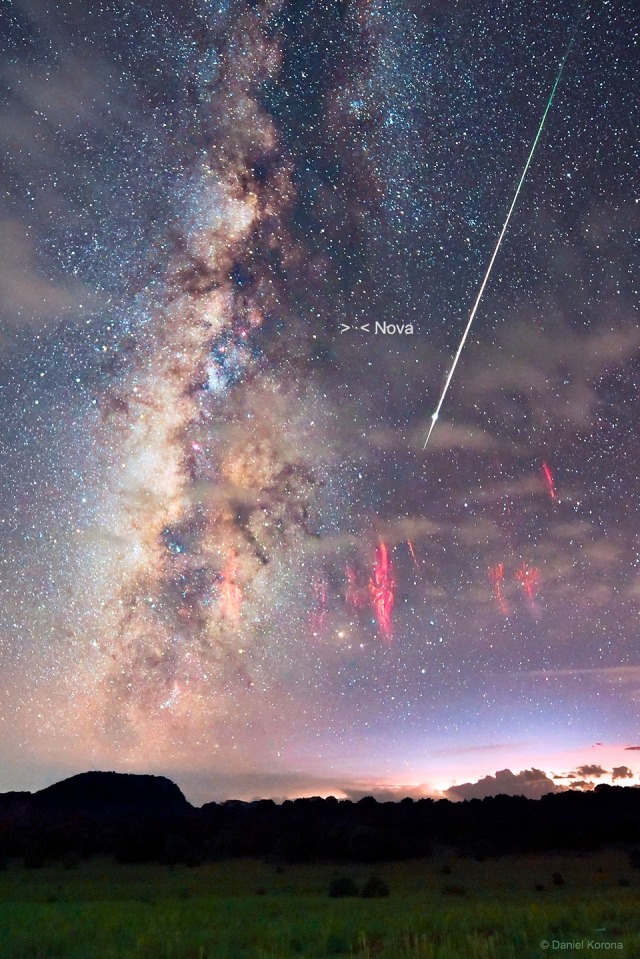
An amazing sky! The Milky Way Galaxy is visible along the left. If you’re near a dark sky, you can usually see part of our galaxy. There is also a bright meteor visible on the upper right, part of a very bright Perseid Meteor Shower from last week. Red sprites, a type of lightening visible on the lower right, also make an appearance in this image. Nova RS Ophiuchus discovered about a week ago, is visible just above the image center. Novas bright enough to be seen with the unaided eye occur every few years. It was such a special occurrence to capture all these things together, in a single night, on a single sky, above Zacatecas, Mexico.
Image Credit & Copyright: Daniel Korona

Sunspots!! They are planet-sized dark spots in the solar photosphere, aka the surface of the Sun. Found in active regions, sunspots look dark because they are slightly cooler than the rest of the surface. The temperature of sunspots is usually about 4,000 kelvins compared to the rest of the surface at 6,000 kelvins. These sunspots in the above image are in active region AR2835, which also happens to be the largest active region now crossing the Sun. The picture shows a field of view that spans about 150,000 kilometers or over ten Earth diameters. With powerful magnetic fields, solar active regions are often responsible for solar flares and coronal mass ejections, storms which affect space weather near Earth.
Image Credit & Copyright: Michael Teoh, Heng Ee Observatory, Penang, Malaysia

Young blue stars circling the galactic center dominate the Andromeda Galaxy in this image taken in ultraviolet! About 2.5 million light-years away, the Andromeda Galaxy, also known as M31, really is our galactic neighbour. Spanning about 230,000 light-years, it took 11 different image fields from NASA’s Galaxy Evolution Explorer (GALEX) satellite telescope to produce this gorgeous portrait of the spiral galaxy in ultraviolet light in 2003. Its spiral arms stand out in visible light images, Andromeda’s arms are sites of intense star formation. They have been interpreted as evidence that Andromeda collided with its smaller neighboring elliptical galaxy M32 more than 200 million years ago. The Andromeda galaxy and our own comparable Milky Way galaxy are the most massive members of the Local Group of galaxies and are projected to collide in several billion years – perhaps around the time that our Sun’s atmosphere will expand to engulf the Earth.
Image Credit: NASA, JPL-Caltech, GALEX

An enhanced Scorpius constellation!! If it looked this good to the unaided eye, we might might remember it better, typically appears as a few bright stars in a constellation. To get a spectacular image like this, though, you’d need a good camera, a dark sky, and some sophisticated image processing. The resulting digitally-enhanced image shows many breathtaking features. Diagonal across the right side of the image is part of the Milky Way Galaxy. Visible there are vast clouds of bright stars and long filaments of dust. Rising vertically on the left are dark dust bands known as the Dark River. Several of the bright stars on the left are part of Scorpius’ head and claws, and include the bright star Antares. Numerous red emission nebulas, blue reflection nebulas, and dark filaments are visible as well. Scorpius appears prominently in southern skies after sunset during the middle of the year.
Image Credit & Copyright: Stefan Lenz

The solar eclipse from June 10, photographed from a fishing pier in Connecticut, USA!
A solar eclipse happens when the moon comes in between the sun and earth, partially (or fully) blocking the sun. This eclipse was annular, meaning that the moon didn’t fully block the sun- during the full phase it covered the middle but not the edges, creating a ‘ring of fire’ look to it!
Was anyone else able to catch it?
Image Credit & Copyright: Elliot Severn

The red shadow of planet Earth is broadcasted across the moon in this image taken on May 26 near Sydney, Australia. On that crisp, clear autumn night a perigee full moon (the moon at its closest point to Earth) slid into the umbra. Its total phase lasted only about 14 minutes which is generally short for a lunar eclipse. The composite of 6 exposures also shows the wide range of brightness variations within Earth’s shadow against a faint background of stars.
Image Credit & Copyright: Peter Ward (Barden Ridge Observatory)
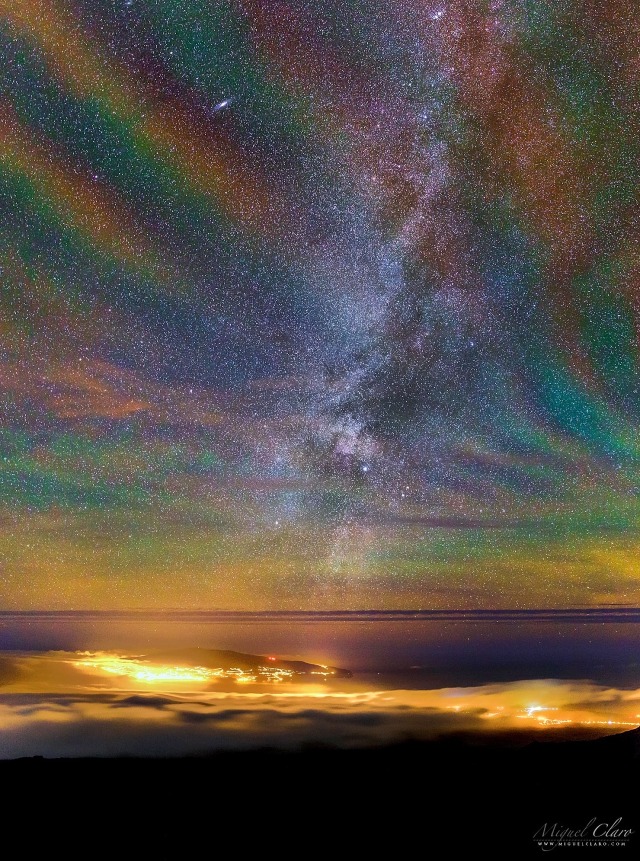
A rainbow airglow! Air glows all of the time, but it is usually hard to see. A disturbance, like a storm, may cause noticeable rippling in the Earth’s atmosphere. These gravity waves are oscillations in air, just like the ripples created when a rock is thrown in calm water. Makes sense right? But where do the colors come from? The deep red glow likely originates from OH molecules excited by ultraviolet light from the Sun. The orange and green airglow is likely caused by sodium and oxygen atoms slightly higher up. A spectacular sky is visible through this airglow, with the central band of our Milky Way Galaxy running up the image center, and M31, the Andromeda Galaxy, visible near the top left.
Image Credit & Copyright: Miguel Claro (TWAN); Rollover Annotation: Judy Schmidt

Happy Earth day!
Marking the passage of day into night in this gorgeous view of ocean and clouds over our planet Earth, the shadow line or terminator is diffuse and shows the gradual transition to darkness we refer to as twilight. With the Sun illuminating the scene from the right, the cloud tops reflect gently reddened sunlight filtered through the dusty troposphere, the lowest layer of Earth’s atmosphere. A clear high altitude layer, visible along the dayside’s upper edge, scatters blue sunlight and fades into the blackness of space. This picture was taken in June of 2001 from the International Space Station.
Image Credit: ISS Expedition 2 Crew, Gateway to Astronaut Photography of Earth, NASA

Spiral galaxy, NGC 3521 is about 35 million light-years away, toward the constellation Leo. Relatively bright in planet Earth’s sky, it is easily visible in small telescopes but often overlooked by amateur imagers in favor of other, more popular, spiral galaxies, like M66 and M65. It’s hard to overlook in this colorful cosmic portrait, though. Spanning some 50,000 light-years the galaxy has characteristic patchy, irregular spiral arms laced with dust, pink star forming regions, and clusters of young, blue stars. This image also shows the galaxy embedded in gigantic bubble-like shells. They are likely tidal debris, which are streams of stars torn from satellite galaxies that have undergone mergers with NGC 3521 in the distant past.
Happy Easter to everyone who celebrates!
Image Credit & Copyright: Acquisition - Eric Benson, Processing - Dietmar Hager

This insanely detailed scene of a portion of our universe has so many famous stars and nebulae in it! Let’s dive in!! Starting on the far upper left, toward the constellation of Auriga, is the picturesque Flaming Star Nebula (IC 405). Continuing down along the bright arc of our Milky Way Galaxy, from left to right crossing the constellations of the Twins and the Bull, notable appearing nebulas include the Tadpole, Simeis 147, Monkey Head, Jellyfish, Cone and Rosette nebulas. In the upper right quadrant of the image, toward the constellation of Orion, you can see Sh2-264, the half-circle of Barnard’s Loop, and the Horsehead and Orion nebulas. Famous stars in and around Orion include, from left to right, orange Betelgeuse (just right of the image center), blue Bellatrix (just above it), the Orion belt stars of Mintaka, Alnilam, and Alnitak, while bright Rigel appears on the far upper right. This region was captured on 34 separate images, taking over 430 hours of exposure, and digitally combined to reveal the featured image.
Image Credit & Copyright: Alistair Symon
